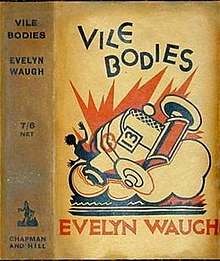Vile Bodies
 Jacket of the first UK edition of Vile Bodies | |
| Author | Evelyn Waugh |
|---|---|
| Country | United Kingdom |
| Language | English |
| Genre | Novel, satire |
| Set in | England, late 1920s |
| Publisher | Chapman & Hall |
Publication date | 1930 |
| Media type | Print (hardback & paperback) |
| Pages | 254 |
| ISBN | 0-14-118287-3 |
| OCLC | 42700827 |
| 823.912 | |
| LC Class | PR6045 .A97 |
| Preceded by | Decline and Fall |
| Followed by | Black Mischief |
Vile Bodies is a 1930 novel by Evelyn Waugh satirising the bright young things: decadent young London society after World War I.
Title
The original title was to be Bright Young Things, which went on to be that of Stephen Fry's 2003 film adaptation. Waugh changed it because he thought the phrase had become too clichéd. The title that he eventually settled on also appears in a comment made by the novel's narrator in reference to the characters' party-driven lifestyle: "All that succession and repetition of massed humanity... Those vile bodies...".[1]
The name seems to come from the Latin phrase Fiat experimentum in corpore vili ("Let the experiment be done upon a worthless body"), which is cited by Boswell, De Quincey, Thackeray and others.
The phrase 'vile body' appears in the bible: "Who shall change our vile body, that it may be fashioned like unto his glorious body?" (Philippians 3:21, King James Version).
Style
Heavily influenced by the cinema and by the disjointed style of T. S. Eliot, Vile Bodies is Waugh's second and most ostentatiously "modern" novel.[2] Fragments of dialogue and rapid scene changes are held together by the dry, almost perversely unflappable narrator.[3] Waugh said it was the first novel in which much of the dialogue takes place on the telephone.
The book was dedicated to B. G. and D. G. (Bryan and Diana Guinness).[4]
Summary
Adam Fenwick-Symes is the novel's antihero; his quest to marry Nina parodies the conventions of romantic comedy, as the traditional foils and allies prove distracted and ineffectual. War looms, Adam's circle of friends disintegrates, and Adam and Nina's engagement founders. At the book's end, we find Adam alone on an apocalyptic European battlefield. The book shifts in tone from light-hearted romp to bleak desolation (Waugh himself later attributed it to the breakdown of his first marriage halfway through the book's composition).[5] Others have defended the novel's curious ending as a poetically just reversal of the conventions of comic romance.[6][7]
Influence
David Bowie cited the novel as the primary influence on his composition of the song "Aladdin Sane".[8]
A stage adaptation of Vile Bodies, endorsed by the Evelyn Waugh estate, was staged at the Warwick Arts Centre in March 2012.[9][10]
Characters
- Adam Fenwick-Symes
- Nina Blount
- Ginger Littlejohn
- Colonel Blount
- The Drunken Major
- Lottie Crump
- The Honourable Agatha Runcible
- Simon Balcairn
- Miles Malpractice
- Mrs Melrose Ape
References
- ↑ Waugh Vile Bodies, p. 104.
- ↑ Frick "Style and Structure".
- ↑ Waugh, Evelyn, Vile Bodies, p. 146. A good example is the death of Simon Balcairn, a declining earl whose gossip columnist name is "Mr. Chatterbox"; his death forms a bridge between chapters VI and VII. ("He shut the door and the window and opened the door of the gas-oven. Inside it was very black and dirty and smelled of meat. He spread a sheet of newspaper on the lowest tray and lay down, resting his head on it. Then he noticed that by some mischance he had chosen Vanburgh's gossip-page in the Morning Despatch. He put in another sheet. At first he held his breath. Then he thought that was silly and gave a sniff. The sniff made him cough, and coughing made him breathe, and breathing made him feel very ill; but soon he fell into a coma and presently died ... Then Adam became Mr. Chatterbox.")
- ↑ "Obituary: Lady Diana Mosley". BBC. 13 August 2003. Retrieved 26 May 2013.
- ↑ Waugh Preface to the 1965 edition.
- ↑ Hollis Evelyn Waugh.
- ↑ O'Dea "What's in a Name?".
- ↑ Circus magazine, July 1973
- ↑ http://www.warwickartscentre.co.uk/events/theatre/evelyn-waughs-vile-bodies%5Bdead+link%5D
- ↑ "Evelyn Waugh's Vile Bodies". Evelyn Waugh's Vile Bodies.
Further reading
- Frick, Robert (Fall 1992). "Style and Structure in the Early Novels of Evelyn Waugh". Papers on Language and Literature. 28 (4). ISSN 0031-1294. OCLC 2449428.
- Hastings, Selina (1994). Evelyn Waugh: A Biography. London: Sinclair-Stevenson. ISBN 1-85619-223-7. OCLC 34721492.
- Hollis, Christopher (1971). Evelyn Waugh. London: Longman. ISBN 0-582-01046-2. OCLC 1159162.
- McDonnell, Jacqueline (1998) [1988]. Evelyn Waugh. London: Macmillan. ISBN 0-312-01618-2. OCLC 16900955.
- Meyers, William (1991). Evelyn Waugh and the Problem of Evil. London: Faber & Faber. ISBN 0-571-14094-7. OCLC 23594793.
- O'Dea, Denise (August 2004). "What's in a Name? Or, Vile Bodies Revisited". Philament: an online journal of the arts and culture. 4. ISSN 1449-0471. OCLC 56720065.
- DJ Taylor (29 September 2007). "The beautiful and the damned". The Guardian Review, adapted from DJ Taylor's "Bright Young People: The Rise and Fall of a Generation 1918–1940". Retrieved 2007-10-08.